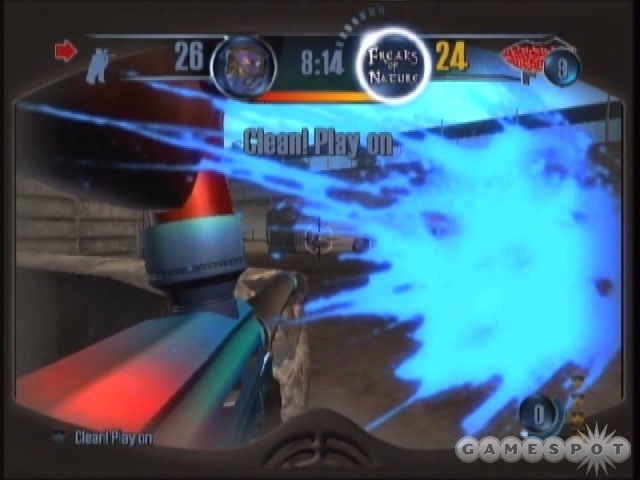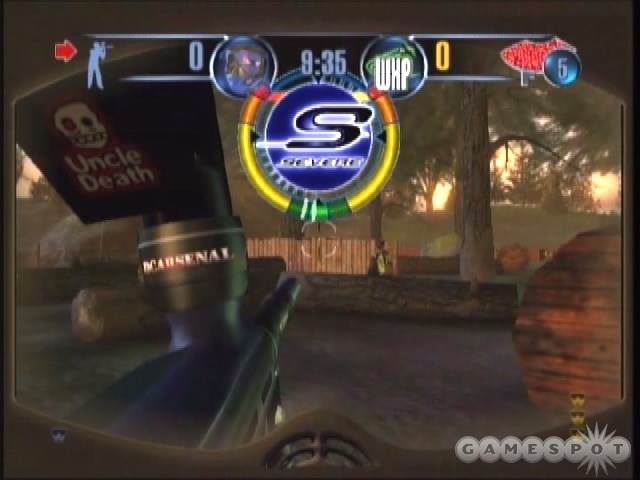The bottom of the game barrel is pretty much hammered together with terrible paintball titles. That may be in part because shooters and real-life paintball are both war simulations, making paintball-themed shooters a simulation of a simulation. Scientifically speaking, having that many layers of abstraction is bound to dilute the thrill of combat. Or at least that was our theory before Greg Hastings' Tournament Paintball, which manages to combine the extreme sports and shooter genres with surprisingly good results.
The game is structured as a series of bracketed tournaments that take place in more than 20 venues across the US, Europe, and Asia. You create a character using one of several extreme-sports archetypes (punk girl, surfer guy, and so on), and assign him or her skills in four different categories: speed, accuracy, reload, and marker ("marker" being paintball-speak for "gun"). You then choose a team of up to six other 'ballers to take on the road with you. As you win tournaments, more-skilled teammates become available for recruitment. Eventually, you'll gain access to pros such as Greg Hastings, Matty Marshal, Nicky Cuba, and other people you've never heard of unless you're really, really into the hardcore paintball scene. You also accrue experience points that increase your basic skills and earn credits that you can trade for better equipment. The equipment list includes everything from markers, air tanks, and barrels (all licensed from actual manufacturers such as Tippmann and JT) to fashion accessories like shoes and jerseys.
Rather than the more traditional "woodsball," where players don fatigues and wander around in the forest, the game simulates "speedball," a generally faster-paced game played in small, enclosed arenas. Matches are three-on-three, five-on-five, or seven-on-seven in one of three tournament types. There's elimination (paint everybody on the other team), center flag (grab a flag from the center of the arena and take it to a net hung in the other team's backfield), and capture the flag (a traditional two-flag game).
Since paintball is pretty much the ultimate tactical shooter (one hit anywhere and you're done), utilizing cover is the key to survival. With that in mind, the left trigger is used for "snaps," which are essentially leans. You snap in the opposite direction of the hand that's holding the marker, and you can switch hands with the B button. You can also toggle your snap direction so you peek up over an obstacle rather than to the side. You can sprint for short distances, and make diving, sliding belly flops, which are great for getting behind a barrier while being chased by a hail of paintballs. Finally, you can use the digital pad to quickly look to the left and right without affecting your aim. The interface is somewhat nonstandard, but it becomes intuitive quickly and really works well for a tactical shooter.
Though one hit eliminates you, the game does give you a chance to cheat "death." When you're hit (as long as it isn't a head shot smeared across your mask), a golf-game-like power meter pops up. Press the A button when the meter's needle is in the sweet spot, and you'll wipe the paint off and can slink away with no one the wiser. If you miss the sweet spot by too much, though, you'll be caught cheating and can get up to three of your teammates disqualified. Each time you successfully cheat within a round, the needle starts moving faster. By the third time, it's pretty much a matter of luck. This neat little addition is just one of the many creative design elements the developers included to try to capture the spirit of paintball.
The arenas are pretty small, but the number of obstacles strewn around them and the general lethality of standing in the open for too long makes finding the enemy pretty tricky. Combat is more methodical than run and gun. You advance from cover to cover until you find someone on the other team, at which point, unless you've got the drop on him or her, the two of you generally hunker down for a protracted battle. The markers fire in an arc, and, depending somewhat on your character's skill and the quality of your equipment, they aren't especially accurate, which means you're often spraying paint as fast as possible and hoping for the best.
The cat-and-mouse gameplay is enhanced greatly by terrific enemy artificial intelligence. It's hard to believe that we're saying this about a paintball title, but Greg Hastings' Tournament Paintball features some of the most effective tactical AI ever. Enemies utilize cover extremely well, will attempt to flank you, and will run for new hiding spots while you're pinned down and unable to see them. They pose a serious challenge--and without the benefit of superior numbers traditional to most shooters.

With all that's good about the game, though, there are still some problems. It would have been nice if you'd been able to give some basic commands to your team, or if they had at least communicated with you more, such as shouting out the locations of enemies they've spotted. As it is, you never feel particularly connected to your squad. With just three match types, what amounts to a single weapon with subtle variations, arenas that begin to look and play similarly, and no-frills sound and visuals that aren't much more than serviceable, the game gets repetitive long before it's over. This repetitiveness infects the multiplayer as well. Though the game supports the three single-player game types in seven-on-seven play via Xbox Live and system link (no split-screen multiplayer is included), the (literally) bloodless gameplay seems far less intense and varied than similar offerings in more-traditional shooters.
Still, even if you never finish the tournament mode, this is an oddball tactical shooter that's at least worth a look for its innovative control scheme and unusual structure and pacing. If nothing else, the developer should license the AI to Tom Clancy's people.
